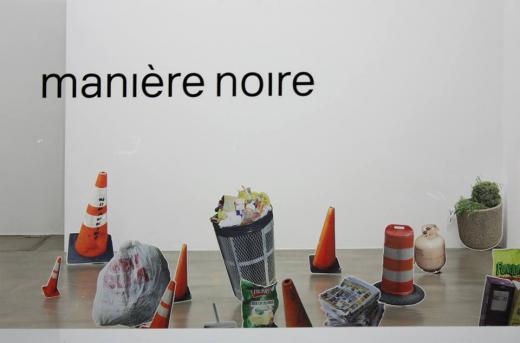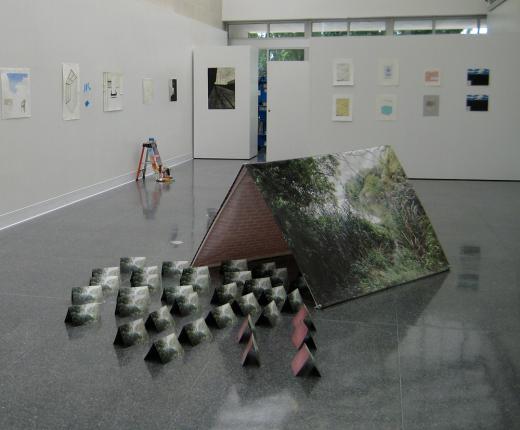Have you met... Amze Emmons
Have you met... Amze Emmons

For the 6th "Picture Window" at Maniere Noire, the Philadelphia-based artist Amze Emmons brought a piece of his city into the gallery space in Berlin. His installation, "Street Life Flat Pack“, is a stage-like set of commercially printed signage sourced from photographs taken in the streets of Philadelphia. The work presents the artist’s questioning of what it means to be local in an age of virtual social engagement and global commerce.
With a multidisciplinary approach that relies mainly on painting, drawing, and print culture, Amze creates politically engaged imagery masked in bright hues and humorous twists. We reached Amze to tell us more about his work, what inspires it, and how it relates to the issues that shape our everyday experiences.

"Picture Window #6 - STREET LIFE FLAT PACK" by Amze Emmons is on view
until November 16, 2016 @ Maniere Noire. Find more info here.
Could you guide us through your work - "Street Life Flat Pack" - currently shown at Maniere Noire?
"Street Life Flat Pack“ came out of the simple act of walking and noticing, two activities that are the starting point for much of my creative process. I’ve been living in Philadelphia for nearly a decade, much of it spent walking around cataloging the street life of the city with my camera. Over time this process began to distill itself into a typology of street furniture. These objects all seemed to have had interesting lives and to point toward larger trends.
At a certain point I had the unlikely idea that I would create facsimiles of all these street objects but stripped of their context. And these in turn could be used like building blocks to recreate an essential version of the city, but easy to distribute and assemble, like Ikea furniture.
I was curious what would be lost or gained by using the tenants of modern web-based commerce as a translating filter. From the start I was interested in using Coroplast as the substrate of the printed cut-outs. This material is often used for cheap, temporary advertisements at convenience stores; it’s not uncommon to see a giant pack of cigarettes or bottle soda strapped to a light pole. I saw a kind of symmetry in repurposing it in this project. And it was important that the final installation create a weak, stage-like reality, an illusion that would quickly break down under any serious scrutiny. I was interested in exploring the space between the real and the fake, it seemed to embodied the folly of the project as a whole.

Amze Emmons, "Street Life Flat Pack"
What exactly does this installation say about the city it refers to? Why did you choose these elements as representative of the local street life?
Good question. In terms of Philadelphia, It says very little. By American standards, Philly is a old city with a rich and complex cultural history. Many of it’s institutions are struggling and much of it’s infrastructure is crumbling. The city leaders wrestle with politics, corruption, and balancing the demands of developers and corporations with meeting the needs of the citizens.
Almost none of the complexity of this can conveyed by looking at "Street Life Flat Pack". I knew the impossibility of this from the beginning. And in a way the failure of the work to convey anything specific is part of what I was counting on. The sense of being a local in a place can’t really be consumed quickly or at a distance. At best the various objects in the installation form a constellation of familiar reference points which convey a pointillist impression. Or maybe a viewer will only see a lot of strange fake garbage.
I choose these objects because of their ubiquity in my walks around the city. I feel the objects make and discarded on an industrial scale evidence some shared cultural values. The traffic cone is the perfect example of what I am interested in here. It was invented in 1943 by Aaron Stanley, an municipal street painter in LA. During the construction of the Eisenhower interstate highway system this object became a ubiquitous symbol of American industrial growth and economic progress; of in a sense, a symbol of American modernity. Jump ahead to today, and traffic cones are everywhere in Philadelphia but rarely signifying progress: they can be found resting in piles beside the road marking half-finished infrastructure projects, or sitting in sink holes alerting drivers to a long-standing traffic problem. They are at best small semi-autonomous monuments to work left undone and at worst, they are conscripted into work as privateers, aiding in piratical efforts by citizens to claim public space for all manner of private use. All of which to say, for me these mid-century utilitarian objects came to embody a strange nostalgia for a what the future used to be.
Although wrapped in humor, the work tackles a bitter topic and inspires dystopian ideas. Considering the increasing virtualisation and commodification of human experience, how do you imagine the future of the city life and the use of physical public space?
Great question, this is a topic I think about a lot. Years ago I read the curator and critic Hou Hanru use the term ‘zones of hybridity’, to refer spaces where people have forced global culture to flow around local modes of engagement. I find this this type of phenomenon, best characterized by ingenious, vernacular design solutions in defiance of mono-culture capitalism as very hopeful. These gestures can be seen as comprising an essential kind of cosmopolitanism. Is it possible to be skeptically optimistic?
Is there a thematic thread between this exhibition and your previous works? Where does your interest in the topic come from?
My art practice has always reflected a keen interest in the intersection between politics, architecture, and place. "Street Life Flat Pack" is evidence of me trying to figure out what being local means in this moment in history. We, or at least I, feel an increasing drift toward dislocation. This is encouraged by spending too much time in web space, where everything looks the same to me no matter where my body is located. And the rise of a new building styles that are informed by global brands, and which seems to perform generic, half-hearted attempts to signify wealth and newness.

Amze Emmons , "National Treasures", 2010 (view more here)

Amze Emmons, "R.U.M. Shelter", 2009 (more info here)
Where do you mainly draw inspiration from?
My three main sources of inspiration are - first, print culture. I’ve always been very interested in way things are printed and distributed. One dividend of printing is that it transfers a kind of distant authority turning anything into a document. I’m terribly interested in the way that cultural authority is used and squandered. And secondly, drawing. I try to model the precarious, erasable, and open nature of the way I draw as a model for thinking about the world. And lastly, the zones of hybridity I referred to above.
What is at the core of your practice? What do you find most important in art?
Definitely noticing. I feel like what I can do as an artist is take the time to notice things other people don’t or can’t. And by spending time with noticed things I begin to extrapolate unlikely connections and illogical conclusions. The most important part of what I’m doing is making the familiar strange. In this way I hope to draw my audience into my way of noticing, and hopefully this will begin a cascade of unlikely outcomes.
Where is this installation going to be shown next?
Actually, a version of the installation is on display currently at the University of Louisville in Louisville, Kentucky, as part of a group exhibition associated with The Mid-American Print Council Conference; a biennial conference of mid-western print artists. After these two installations end, I can’t say where it might go next. The installation is made of printed objects, so I like to take advantage of the way a multiple can be in a few places at once, although the installation layout will change depending on the nature of the location.
Could you tell us something about your upcoming shows / projects?
Besides "Street Life Flat Pack", I’m working on three other projects at the moment. Using wood block printing I’m making small scale version of the kind of vinyl banners that many small business use now. I’ve noticed they often employ the same type faces and clip art whether they say ‘Grand Opening!’ or ‘Going Out of Business!’. And I have an idea that I can tell the story of the recession just using banner language.
Treading the same territory as "Street Life", I’m working on a suite of drawings thinking about vernacular design and street furniture. And as part of the art group Printeresting, I’m helping to organize an artist book/ exhibition/ exchange with artists from the US and Slovenia thinking critically about samizdats and the power of copying.
* * * * *
Picture Window #6 - STREET LIFE FLAT PACK, by Amze Emmons
On view until November 16, 2016 @ Maniere Noire
More info
Curious to find out more about Amze Emmons? amzeemmons.com